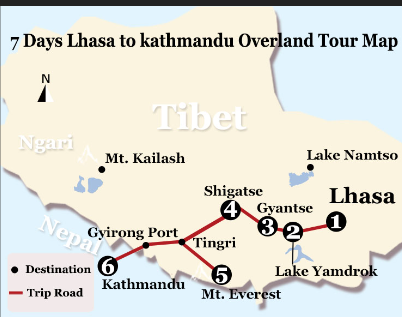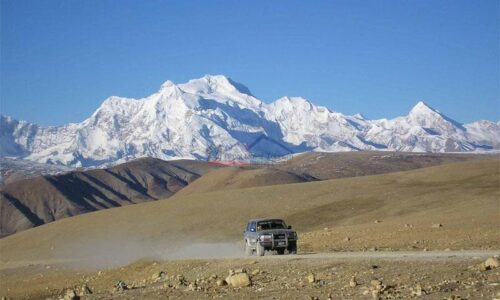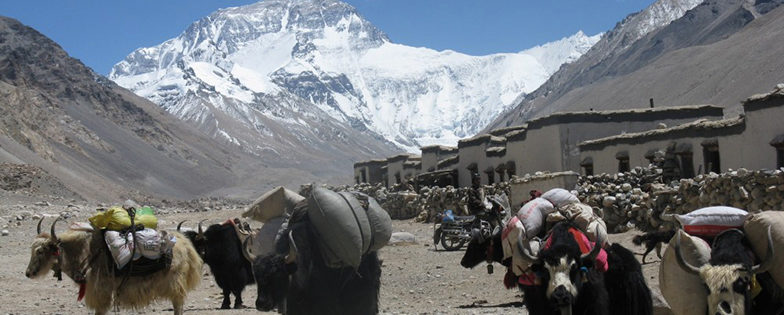- Day 01: Kathmandu (1300) -Kerung Border (145 Km) 06-07 hours drive
- Day 02: Kerung - Tingri (4300m) / Lhatse (4,350m): 225 Km/244 Km
- Day 03: Tingri/Lhaste - Xigatse (3,900 M): 244 Km
- Day 04: Xigatse - Gyantse (3,950m)- Lhasa
- Day 05-06: Sightseeing In Lhasa
- Day 07: Lhasa – Xegar (4300m) 490km
- Day 08: Xegar to Kerong Border to Kathmandu 395km
Day 01: Kathmandu (1300) -Kerung Border (145 Km) 06-07 hours drive
Early in the morning scenic drive to Kerung Border (Nepal-Tibet Border) through the beautiful Nepalese countryside and after necessary border formalities at Nepalese immigration, an hour adventurous uphill drive by Bus & Van (normally) or 2 hour walks uphill (in case of landslide to Chinese immigration, check-in to hotel or Continue drive to Kerung. Stay overnight at Guest House.
Day 02: Kerung - Tingri (4300m) / Lhatse (4,350m): 225 Km/244 Km
Day drive uphill to the highest plateau of the world with the typical view of Tibetan landscape offering sheer feeling of standing on the roof of the world. from where, weather permitting, breathtaking panorama of beautiful Himalayan ranges including Mt Cho Oyu (8201 M) & Mt Xishapagma (8012M) but dwarfed by the Vastness of the Tibetan plateau. From TINGRI, one can enjoy the magnificence of Mt. Everest (8,848 M). Stay overnight at Guest House
Day 03: Tingri/Lhaste - Xigatse (3,900 M): 244 Km
Continue scenic drive crossing Over Gyatchu La (5,220M), the highest pass en route to Lhasa via Lhatse from where a road to Mt Kailash bifurcates to the west. Stay overnight at Yak hotel.
Day 04: Xigatse - Gyantse (3,950m)- Lhasa
Morning sightseeing to the Panchen Lama's Tashilhumpu Monastery. Drive to Gyantse and visit to the Kumbum Stupa & Phalkor Monastery. Full day picturesque drive crossing over Karola (5,010m), Kambala (4,749m), Colorful Yamdrok-Tso Lake and the Tibetan lifeline river Brahma Putra (Yarlung Tsangpo) – Stay overnight at Flora Hotel.
Day 05-06: Sightseeing In Lhasa
Two full days sightseeing tour to Lhasa including Jokhang Temple, Barkhor Bazaar, And Potala Palace Drepung & Sera Monasteries. Stay overnight at Hotel.
Day 07: Lhasa – Xegar (4300m) 490km
Early morning drive to Xegar O/N at Guest House.
Day 08: Xegar to Kerong Border to Kathmandu 395km
Early morning, Drive to Border, cross border- drive back to Kathmandu end Service
Packing lists for 8 days Tibet Overland Tour
- Necessary travel documents
- Lightweight pants, Full sleeve shirts/T-shirts,
- Waterproof and windproof jacket, down jacket
- Thermal innerwear, Extra pairs of socks, comfortable shoes
- warm cap, gloves, scarf
- Cell phone, camera, power banks, chargers
- Snacks and energy bars
- Moisturizer, lip balm, sunscreen cream, and other necessary skin care items
- Some necessary toilet items including small packages of tissues, wet tissues, a quick-dry towel, etc.
- Medi kits
- Extra cash
- Other necessary and personal valuable items

1. What is the best time to visit Tibet?
The best time to visit Tibet is from April to October. During these months, the weather is milder and more suitable for travel, with clear skies offering stunning views of the landscapes.
2. Do I need a visa and permits to travel to Tibet?
Yes, you need a Chinese visa and a Tibet Travel Permit to visit Tibet. The permit must be arranged through a travel agency. Additional permits may be required for certain restricted areas.
3. Is independent travel allowed in Tibet?
Independent travel is not allowed in Tibet. All foreign travelers must book a tour through a licensed travel agency, which will arrange the necessary permits, a guide, and transportation.
- Potala Palace: A UNESCO World Heritage Site and the former winter residence of the Dalai Lama, this iconic palace offers panoramic views of Lhasa and is a masterpiece of Tibetan architecture.
- Jokhang Temple: The spiritual heart of Tibetan Buddhism, this temple is a key pilgrimage site and houses the revered Jowo Shakyamuni Buddha statue.
- Barkhor Street: A bustling market and pilgrimage circuit around Jokhang Temple, offering a vibrant mix of Tibetan culture, crafts, and local life.
- Sera Monastery: Known for its lively debates among monks, this monastery is an important center of Tibetan Buddhist learning.
The best time to visit Tibet largely depends on the experiences you're seeking and the regions you plan to explore. Generally, the most favorable time to visit is from April to October, when the weather is relatively mild and travel conditions are more accessible. Here’s a seasonal breakdown to help you plan your trip.
Spring (April to June)
- Weather: Temperatures start to warm up, with pleasant days and chilly nights. Snow is melting, and the landscapes begin to bloom.
- Advantages: Fewer tourists compared to summer, making for a quieter experience. Good time for trekking and sightseeing with clear skies.
Summer (July to August)
- Weather: Warmer temperatures and more stable weather conditions. However, it’s also the rainy season, which can lead to occasional showers and muddy conditions in some areas.
- Advantages: Best time for high-altitude treks and exploring remote regions like Mount Kailash and the Changtang Plateau. Festivals like Saga Dawa take place during this period.
Autumn (September to October)
- Weather: Cool and dry, with clear skies and crisp air. The landscape is often vibrant with autumn colors, making it ideal for photography.
- Advantages: Excellent weather for outdoor activities and sightseeing. Tourist crowds begin to thin out, providing a more peaceful experience.
Winter (November to March)
- Weather: Cold temperatures, especially at higher elevations, with snow and ice becoming common. Some remote areas may be inaccessible due to harsh weather conditions.
- Advantages: Fewer tourists, and accommodation prices may be lower. The snow-covered landscapes offer a different kind of beauty.
raveling to Tibet is a unique and unforgettable experience, but it requires careful preparation and consideration. Here are some critical points to keep in mind:
1. Permits and Regulations
- Tibet Travel Permit: All foreign travelers must obtain a Tibet Travel Permit through a licensed travel agency. This permit is essential for entering Tibet and must be arranged well in advance.
- Additional Permits: Depending on your travel itinerary, additional permits may be required for specific areas like Mount Kailash or the Ngari region.
2. Health and Altitude
- Acclimatization: The high altitude can pose health risks. Allow time to acclimatize upon arrival and be aware of symptoms of altitude sickness. Consult a healthcare provider before your trip and carry necessary medications.
- Medical Facilities: Medical facilities in Tibet, especially in remote areas, may be limited. Ensure you have comprehensive travel insurance that covers medical emergencies.
3. Cultural Sensitivity
- Respect Local Customs: Tibetan culture is deeply rooted in Buddhism and local traditions. Dress modestly, particularly when visiting religious sites, and be respectful of local customs and practices.
- Photography: Always seek permission before taking photographs of people, especially monks, and religious ceremonies. Some areas and temples may have restrictions on photography.
4.Safety and Emergency Contacts
- Emergency Information: Keep a list of emergency contacts, including local authorities, your tour operator, and your country’s embassy or consulate in China.
- Travel Insurance: Ensure you have comprehensive travel insurance that covers health, accidents, and trip cancellations.
By being mindful of these considerations, you can enjoy a safe and enriching journey through Tibet, experiencing its profound cultural heritage and stunning natural beauty.
Cost Inclusion
- PRIVATE TRANSPORTATION BY VAN/ Minibus
- NECESSARY TIBET TRAVEL PERMIT
- ENGLISH SPEAKING TIBETAN GUIDE.
- ACCOMMODATION ON TWIN SHARING ROOM BASIS
- SIGHTSEEING AND MONASTERY ENTRANCE FEES AS PER OUR ITINERARY
- DAILY BREAKFAST.
- KATHMANDU TO KERONG TO KATHMANDU TRANSFER BY JEEP
Cost Exclusion
- LUNCH AND DINNER
- INSURANCE OF ANY KIND
- PERSONAL EXPENSES SUCH AS A DRINK, TIPS & ETC.
- ANY ADDITIONAL COST DUE TO NATURAL CALAMITIES AND UNFORESEEN CIRCUMSTANCE

